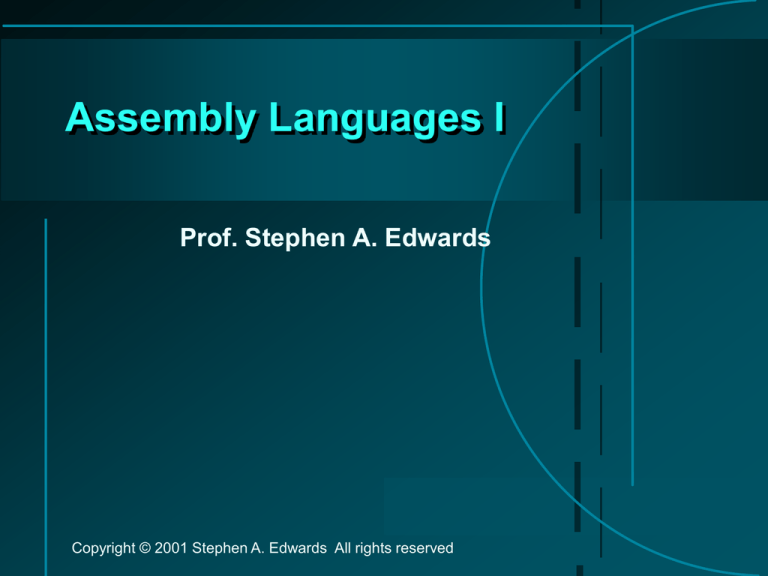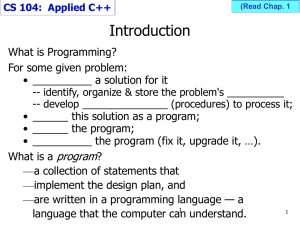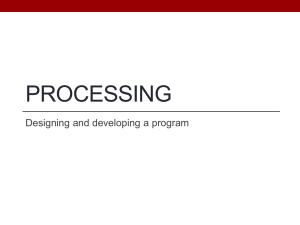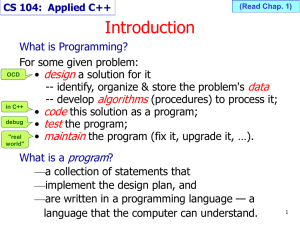
Assembly Languages I
Prof. Stephen A. Edwards
Copyright © 2001 Stephen A. Edwards All rights reserved
Last Time
Languages
Syntax: what’s in the language
Semantics: what the language means
Model: what the language manipulates
Specification asks for something
Modeling asks what something will do
Concurrency
Nondeterminism
Copyright © 2001 Stephen A. Edwards All rights reserved
Assembly Languages
One step up from machine
language
Originally a more user-friendly
way to program
ENIAC, 1946
17k tubes, 5kHz
Now mostly a compiler target
Model of computation: stored
program computer
Copyright © 2001 Stephen A. Edwards All rights reserved
Assembly Language Model
…
add r1,r2
sub r2,r3
PC
cmp r3,r4
bne I1
ALU
sub r4,1
I1: jmp I3
…
Copyright © 2001 Stephen A. Edwards All rights reserved
Registers
Memory
Assembly Language Instructions
Built from two pieces
Add R1, R3, 3
Opcode
Operands
What to do with
the data
Where to get
data and put
the results
(ALU operation)
Copyright © 2001 Stephen A. Edwards All rights reserved
Types of Opcodes
Arithmetic, logical
•
•
•
add, sub, mult
and, or
Cmp
Memory load/store
•
ld, st
Control transfer
•
•
jmp
bne
Complex
•
movs
Copyright © 2001 Stephen A. Edwards All rights reserved
Operands
Each operand taken from a particular
addressing mode:
Examples:
Register
add r1, r2, r3
Immediate
add r1, r2, 10
Indirect
mov r1, (r2)
Offset
mov r1, 10(r3)
PC Relative
beq 100
Reflect processor data pathways
Copyright © 2001 Stephen A. Edwards All rights reserved
Types of Assembly Languages
Assembly language closely tied to processor
architecture
At least four main types:
CISC: Complex Instruction-Set Computer
RISC: Reduced Instruction-Set Computer
DSP: Digital Signal Processor
VLIW: Very Long Instruction Word
Copyright © 2001 Stephen A. Edwards All rights reserved
CISC Assembly Language
Developed when people wrote assembly language
Complicated, often specialized instructions with
many effects
Examples from x86 architecture
•
•
String move
Procedure enter, leave
Many, complicated addressing modes
So complicated, often executed by a little program
(microcode)
Copyright © 2001 Stephen A. Edwards All rights reserved
RISC Assembly Language
Response to growing use of compilers
Easier-to-target, uniform instruction sets
“Make the most common operations as fast as
possible”
Load-store architecture:
•
•
Arithmetic only performed on registers
Memory load/store instructions for memory-register
transfers
Designed to be pipelined
Copyright © 2001 Stephen A. Edwards All rights reserved
DSP Assembly Language
Digital signal processors designed specifically for
signal processing algorithms
Lots of regular arithmetic on vectors
Often written by hand
Irregular architectures to save power, area
Substantial instruction-level parallelism
Copyright © 2001 Stephen A. Edwards All rights reserved
VLIW Assembly Language
Response to growing desire for instruction-level
parallelism
Using more transistors cheaper than running them
faster
Many parallel ALUs
Objective: keep them all busy all the time
Heavily pipelined
More regular instruction set
Very difficult to program by hand
Looks like parallel RISC instructions
Copyright © 2001 Stephen A. Edwards All rights reserved
Types of Assembly Languages
CISC
RISC
DSP
VLIW
Few,
Complex
Few,
Simple
Opcodes
Many,
Few,
Complex Simple
Registers
Few,
Special
Many,
Few,
General Special
Many,
General
Addressing
modes
Many
Few
Special
Few
Instructionlevel
Parallelism
None
None
Restricted Plenty
Copyright © 2001 Stephen A. Edwards All rights reserved
Gratuitous Picture
Woolworth building
Cass Gilbert, 1913
Application of the Gothic
style to a 792’ skyscraper
Tallest building in the
world when it was
constructed
Downtown: near City Hall
Copyright © 2001 Stephen A. Edwards All rights reserved
Example: Euclid’s Algorithm
In C:
Two integer parameters
int gcd(int m, int n)
One local variable
{
Remainder operation
int r;
while ( (r = m % n) != 0) {
m = n;
n = r;
Non-zero test
}
Data transfer
return n;
}
Copyright © 2001 Stephen A. Edwards All rights reserved
i386 Programmer’s Model
31
0
eax
ebx
ecx
edx
esi
15
Mostly
generalpurpose
registers
Source index
edi
Destination index
ebp
Base pointer
esp
Stack pointer
eflags
eip
Status word
Instruction Pointer (PC)
Copyright © 2001 Stephen A. Edwards All rights reserved
0
cs
Code
ds
Data
ss
Stack
es
Extra
fs
Data
gs
Data
Segment
Registers:
Added during
address
computation
Euclid’s Algorithm on the i386
.file "euclid.c"
.version
"01.01"
gcc2_compiled.:
.text
.align 4
.globl gcd
.type gcd,@function
gcd:
pushl %ebp
movl %esp,%ebp
pushl %ebx
movl 8(%ebp),%eax
movl 12(%ebp),%ecx
jmp .L6
.p2align 4,,7
Boilerplate
Assembler directives start with “ ”
“This will be executable code”
.
“Start on a 16-byte boundary”
“gcd is a linker-visible label”
Copyright © 2001 Stephen A. Edwards All rights reserved
Euclid’s Algorithm on the i386
.file "euclid.c"
.version
"01.01"
gcc2_compiled.:
.text
.align 4
.globl gcd
.type gcd,@function
gcd:
pushl %ebp
movl %esp,%ebp
pushl %ebx
movl 8(%ebp),%eax
movl 12(%ebp),%ecx
jmp .L6
Stack before call
%esp
n
8(%esp)
m
4(%esp)
return
0(%esp)
Stack after entry
%ebp
%esp
Copyright © 2001 Stephen A. Edwards All rights reserved
n
12(%ebp)
m
8(%ebp)
return
4(%ebp)
old epb 0(%ebp)
old ebx -4(%ebp)
Euclid’s Algorithm on the i386
jmp .L6
.p2align 4,,7
.L4:
movl %ecx,%eax
movl %ebx,%ecx
.L6:
cltd
idivl %ecx
movl %edx,%ebx
testl %edx,%edx
jne .L4
movl %ecx,%eax
movl -4(%ebp),%ebx
leave
ret
“Jump to local label .L6”
“Skip as many as 7 bytes to
start on a 16-byte boundary”
“Sign-extend %eax to %edx:%eax”
“Compute %edx:%eax %ecx:
quotient in %eax, remainder in %edx”
Copyright © 2001 Stephen A. Edwards All rights reserved
Register assignments:
%eax
m
%ebx
r
%ecx
n
while ((r = m % n) != 0) {
m = n;
n = r;
}
return n;
Euclid’s Algorithm on the i386
jmp .L6
.p2align 4,,7
.L4:
movl %ecx,%eax
movl %ebx,%ecx
“m = n”
“n = r”
.L6:
cltd
idivl %ecx
movl %edx,%ebx
testl %edx,%edx
jne .L4
movl %ecx,%eax
movl -4(%ebp),%ebx
leave
ret
“compute AND of %edx and %edx,
update the status word, discard the
result”
“Branch back to .L4 if the zero flag is
clear, I.e., the last arithmetic
operation did not produce zero”
Copyright © 2001 Stephen A. Edwards All rights reserved
while ((r = m % n) != 0) {
m = n;
n = r;
}
return n;
Euclid’s Algorithm on the i386
Stack before exit
jmp .L6
.p2align 4,,7
.L4:
movl %ecx,%eax
movl %ebx,%ecx
.L6:
cltd
idivl %ecx
movl %edx,%ebx
testl %edx,%edx
jne .L4
movl %ecx,%eax
movl -4(%ebp),%ebx
leave
ret
%ebp
%esp
n
12(%ebp)
m
8(%ebp)
return
4(%ebp)
old epb 0(%ebp)
old ebx -4(%ebp)
“return n” (caller expects value in %eax)
“move %ebp to %esp and
pop %ebp from the stack”
“Pop a return address from the
stack and branch to it”
Copyright © 2001 Stephen A. Edwards All rights reserved
Another Gratuitous Picture
Types of Bridges
Truss
(Forth Bridge, Scotland)
Suspension
(Golden Gate Bridge,
California)
Copyright © 2001 Stephen A. Edwards All rights reserved
Cable-stayed
(Higashi Kobe,
Japan)
SPARC Programmer’s Model
31
0
r0
31
0
r16/l0
7 global
registers
r23/l7
…
R0 is always 0
r1
…
r7
…
r14/o6
8 output
registers
Stack Pointer
…
r8/o0
r24/i0
8 local
registers
8 input registers
r30/i6
Frame Pointer
r31/i7
Return Address
PSW
Program Status Word
r15/o7
PC
Program Counter
nPC
Next Program Counter
Copyright © 2001 Stephen A. Edwards All rights reserved
SPARC Register Windows
…
r8/o0
r15/o7
r16/l0
r8/o0
The global registers remain
unchanged
r15/o7
r16/l0
The local registers are not
visible across procedures
r23/l7
r24/i0
…
The output registers of the
calling procedure become
the inputs to the called
procedure
…
…
r23/l7
r24/i0
r31/i7
Copyright © 2001 Stephen A. Edwards All rights reserved
…
…
r15/o7
r16/l0
r31/i7
…
…
…
r8/o0
r23/l7
r24/i0
r31/i7
Euclid’s Algorithm on the SPARC
.file "euclid.c"
gcc2_compiled.:
.global .rem
.section
".text"
.align 4
.global gcd
.type gcd,#function
.proc 04
gcd:
save %sp, -112, %sp
Boilerplate
Assembler directives start with “ ”
“This will be executable code”
.
“gcd is a linker-visible label”
mov %i0, %o1
b
.LL3
mov %i1, %i0
Copyright © 2001 Stephen A. Edwards All rights reserved
Pipelining
None
Fetch
Decode
Execute
Write
Fetch
Pipelined
Fetch
Decode
Execute
Write
Fetch
Decode
Execute
Write
Superscalar
Fetch
Decode
Execute
Write
Fetch
Decode
Execute
Write
Fetch
Decode
Execute
Write
Fetch
Decode
Execute
Write
Copyright © 2001 Stephen A. Edwards All rights reserved
Decode
Execu
Euclid’s Algorithm on the SPARC
.file "euclid.c"
gcc2_compiled.:
.global .rem
.section
".text"
.align 4
.global gcd
.type gcd,#function
.proc 04
gcd:
save %sp, -112, %sp
mov %i0, %o1
b
.LL3
mov %i1, %i0
“Advance the register windows.
Allocate space on the stack.”
“Move argument 0 (m) into %o1”
“Branch to .LL3 after executing
the next instruction”
The SPARC doesn’t have a mov instruction:
the assembler replaces this with
or %g0, %i1, %i0
Copyright © 2001 Stephen A. Edwards All rights reserved
Euclid’s Algorithm on the SPARC
mov %i0, %o1
b
.LL3
mov %i1, %i0
.LL5:
mov %o0, %i0
.LL3:
mov %o1, %o0
call .rem, 0
mov %i0, %o1
cmp %o0, 0
bne .LL5
mov %i0, %o1
ret
restore
while ((r = m % n) != 0) {
m = n;
n = r;
}
return n;
“Compute the remainder of
m n (result in %o0)”
Call is also delayed
Register assignments:
m
%o1
r
%o0
n
%i0
Copyright © 2001 Stephen A. Edwards All rights reserved
Euclid’s Algorithm on the SPARC
mov %i0, %o1
b
.LL3
mov %i1, %i0
.LL5:
mov %o0, %i0
.LL3:
mov %o1, %o0
call .rem, 0
mov %i0, %o1
cmp %o0, 0
bne .LL5
mov %i0, %o1
ret
restore
while ((r = m % n) != 0) {
m = n;
n = r;
Register assignments:
}
return n;
m
%o1
Copyright © 2001 Stephen A. Edwards All rights reserved
r
n
%o0
%i0
“n = r”
“m = n” (executed even if
loop terminates)
“Branch back to caller”
SPARC has no ret: this is
jmp %i7 + 8
Inverse of save:
return to previous
register window



